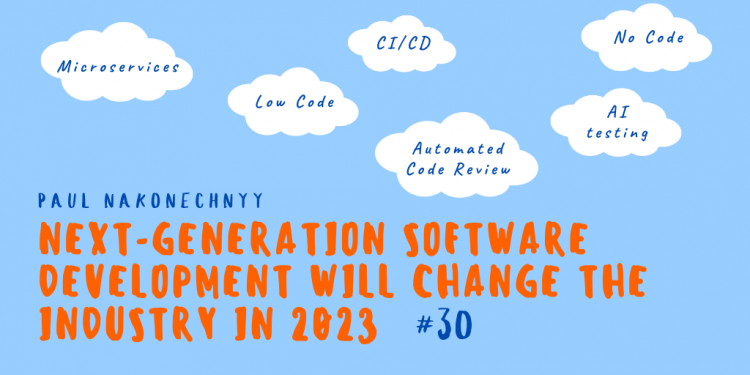🦾 Next-generation software development will change the industry in 2023
Published by Pavel Nakonechnyy on in Leadership and Soft Skills.
The next generation of software development tooling improves processes and software quality across each stage of the software development life cycle (SDLC) enabling more and more nontechnical employees to create applications. These tools include technologies like low-code/no-code platforms, infrastructure-as-code, microservices and APIs, AI “pair programmers”, AI-based testing, and Automated code review.
Even though these technologies aren’t widely adopted now, they present a great opportunity to leaders. For example. companies leveraging low-code or no-code development speed up development up to ~90%, increase deployment speed twice, allow testing better and faster, and reduce resolution time. Gartner predicts that by 2025 ~70% of new application development will leverage low-code or no-code.
Now, companies rely on dedicated developers involved in software development from planning to maintenance, resulting in high costs, talent gaps, and slow development cycles. At the same time, dedicated IT teams perform infrastructure configuration and monitoring manually, which causes security risks and task repetition.
With the adoption of next-gen development technologies, the participation of tech teams will be greatly reduced as Business users with insignificant technical experience will be able to develop simple business applications alone. It facilitates the quick development of solutions better aligned with business needs.
IT teams will apply automated infrastructure configuration and monitoring with fully automated CI/CD pipelines resulting in better productivity and security, lesser downtime, higher code quality, and shorter development cycles.
These technologies will have an impact on software development across all industries. For example, Financial services will be able to update business rules for corporate processes (e.g., KYC and customer due diligence) on the Local Business level to comply with country regulations. Healthcare providers and producers of drugs will be able to tailor their processes of handling customer data, and the development and testing of new drugs.
McKinsey in their research Technology Trends Outlook 2022 has collected several examples of companies already leveraging next-gen software development:
-
Decathlon used infrastructure-as-code to automate infrastructure deployment, reducing deployment time from weeks to 30 minutes, and allowing IT teams to focus on a more complex task.
-
Capital One leverages microservices and automated CI/CD to increase delivery speed without compromising quality through reusable building blocks and the generation of templated pipelines.
-
Goldman Sachs uses the AI-based tool Diffblue Cover to generate unit tests for legacy software, leading to a 180× increase in the speed of writing tests for a core back-end application.
-
Atlassian uses AI-based tools by Amazon Web Services to improve code performance by identifying code paths that demonstrate poor CPU2 utilization or latency
Adoption may be slow because of technical challenges, the need for large-scale retraining of developers and test engineers, and organizational hurdles. Nevertheless, the new technologies could accelerate digital transformation, deliver productivity gains, and lessen the need to recruit from a scarce, competitive pool of engineering talent.